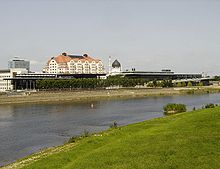Elbezweigbahn
| Dresden-Altstadt – Dresden-Altstadt Elbe bank | |||||||||||||||||||||||||||||||||||||||||||||||||||||||||||||||||||||||||||||||||||||||||
|---|---|---|---|---|---|---|---|---|---|---|---|---|---|---|---|---|---|---|---|---|---|---|---|---|---|---|---|---|---|---|---|---|---|---|---|---|---|---|---|---|---|---|---|---|---|---|---|---|---|---|---|---|---|---|---|---|---|---|---|---|---|---|---|---|---|---|---|---|---|---|---|---|---|---|---|---|---|---|---|---|---|---|---|---|---|---|---|---|---|
| Route number : | 6662; sä. DWK | ||||||||||||||||||||||||||||||||||||||||||||||||||||||||||||||||||||||||||||||||||||||||
| Course book range : | - | ||||||||||||||||||||||||||||||||||||||||||||||||||||||||||||||||||||||||||||||||||||||||
| Route length: | 4,300 km | ||||||||||||||||||||||||||||||||||||||||||||||||||||||||||||||||||||||||||||||||||||||||
| Gauge : | 1435 mm ( standard gauge ) | ||||||||||||||||||||||||||||||||||||||||||||||||||||||||||||||||||||||||||||||||||||||||
| Maximum slope : | 2.08 ‰ | ||||||||||||||||||||||||||||||||||||||||||||||||||||||||||||||||||||||||||||||||||||||||
| Minimum radius : | 170 m | ||||||||||||||||||||||||||||||||||||||||||||||||||||||||||||||||||||||||||||||||||||||||
| Dual track : | Dresden-Altstadt – Dresden-Altstadt Kohlenbf | ||||||||||||||||||||||||||||||||||||||||||||||||||||||||||||||||||||||||||||||||||||||||
|
|||||||||||||||||||||||||||||||||||||||||||||||||||||||||||||||||||||||||||||||||||||||||
The Elbezweigbahn was a branch line serving only goods traffic in the urban area of the Saxon state capital Dresden , which was originally built and operated as a coal railway by Albertsbahn AG . It began at the Dresden-Altstadt freight station and led along the original course of the Weißeritz to the port facilities on the banks of the Elbe in the old town.
history
The history of the Elbezweigbahn is directly linked to the history of Albertsbahn AG, which operated a rail connection from Dresden to Tharandt from June 28, 1855. This route was originally built as a coal railway to carry the coal extracted from the Döhlen Basin , but it was also used for tourist traffic. The end point of the line in Dresden was the Albertsbahnhof southwest of Dresden's old town, it is identical to the later coal station.
On April 2, 1856, the Albertsbahn AG opened another line from the Albertsbahnhof to the port facilities on the banks of the Elbe. This route, known as the Elbezweigbahn , only served goods traffic throughout its existence. To reload the coal, there was an unloading frame on the quay, on which the coal hunte of the Albertsbahn AG could be emptied under the floor. The coal was then brought to the ships on the quay by handcarts.
On March 1, 1859, the Saxon state opened a branch track from the Elbufer station to the Packhof , and the Albertsbahn also operated here.
On July 1, 1868, the Albertsbahn was nationalized. The route was now owned by the Royal Saxon State Railways . In the Saxon route designation scheme, the Elbezweigbahn routes were given the abbreviations DWK (Dresden-Altstadt-Elbufer) and DWP (Elbufer-Packhof). From March 1, 1869, trains from Tharandt ran via a new connecting line to the Bohemian Railway Station (now the main train station), from then on the Albertsbahnhof was only used as a freight station. It was renamed Dresden-Altstadt coal station.
The Royal Saxon State Railways expanded the track system on the banks of the Dresden Elbe considerably between 1882 and 1884. In 1891, the relocation of the Weißeritz finally began. Among other things, the new Dresden wholesale market hall was built on the new space gained . It got its own loading point.
The opening of the new König-Albert-Hafen in the Ostragehege in 1895 led to a reduction in the handling of goods on the banks of the Elbe in the old town. The Dresden-Altstadt Elbufer station was connected to the Dresden-Friedrichstadt marshalling yard, which was in operation at the same time, via the new Dresden port railway , which was also built .

However, the state district heating and electricity works built on the Packhof premises in 1900 , the municipal cold store built in 1911 and the municipal storage facility built between 1913 and 1914 caused the volume of traffic on the Elbe branch line to increase again later. In addition, the Mitte power plant was built in 1927/1928 on the site of a smaller lighting plant on Wettiner Platz , at that time one of the most modern heating power plants in Germany. From then on, it took over the district heating supply of the public buildings in the inner city of Dresden, the old state district heating and electricity plant was then taken out of operation.

The air raids on February 13, 1945 marked a turning point for the Elbezweigbahn . Most of the route was in the area of the 90 percent destroyed old town. The state district heating and electricity plant was completely destroyed, the storage facilities burned out, and the coal station devastated. However, the Mitte power plant and the wholesale market hall remained largely intact. The Dresden-Altstadt Elbufer station was henceforth only used as a storage area. It was now operated exclusively via the port railway.
After the political change in eastern Germany in 1989, there was a rapid drop in traffic on the route. The Mitte power plant was shut down in March 1994, and the wholesale market hall and cold store also ceased operations. With the conversion of the heating systems in Dresden households from coal to more modern energy sources, the coal station finally lost its function.
Today the route from the Freiberger Straße overpass is dismantled. The former train station on the banks of the Elbe now serves as a parking lot for coaches. Several times a year it is also used as a fairground for the Dresden bird meadow .
literature
- Kurt Kaiß, Matthias Hengst: Dresden's Railway 1894–1994 . Alba Verlag, Düsseldorf 1994, ISBN 3-87094-350-5 .
- Erich Preuß, Reiner Preuß: Saxon State Railways. transpress Verlagsgesellschaft mbH, Berlin 1991, ISBN 3-344-70700-0 .
Web links
Individual evidence
- ^ Jürgen Schubert: The Windbergbahn Kenning Verlag 1993; P. 24


